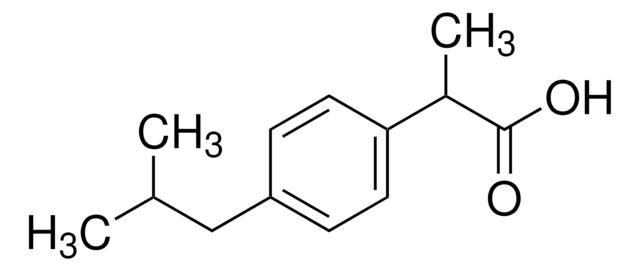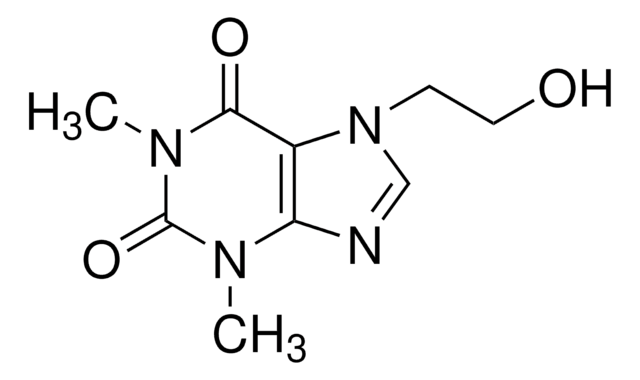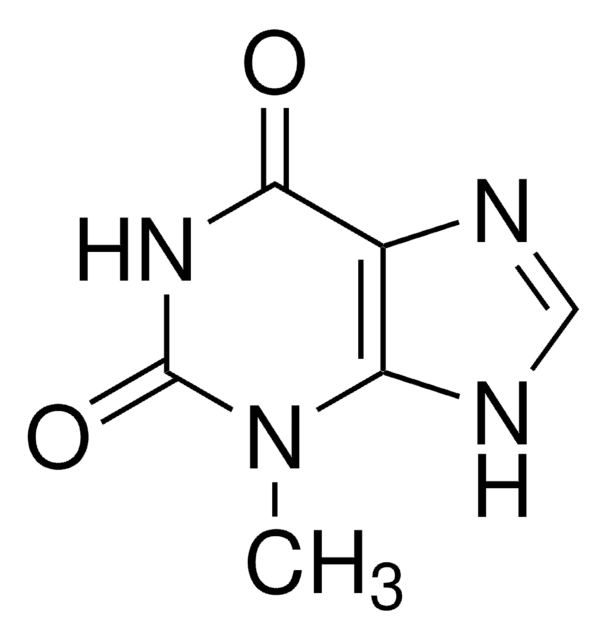Kluczowe dokumenty
1085003
USP
Caffeine
United States Pharmacopeia (USP) Reference Standard
Synonim(y):
1H-puryno-2,6-dion
About This Item
Polecane produkty
klasa czystości
pharmaceutical primary standard
rodzina API
pentoxifylline, caffeine, dimenhydrinate
producent / nazwa handlowa
USP
mp
234-236.5 °C (lit.)
Zastosowanie
pharmaceutical (small molecule)
Format
neat
ciąg SMILES
CN1C(=O)N(C)c2ncn(C)c2C1=O
InChI
1S/C8H10N4O2/c1-10-4-9-6-5(10)7(13)12(3)8(14)11(6)2/h4H,1-3H3
Klucz InChI
RYYVLZVUVIJVGH-UHFFFAOYSA-N
informacje o genach
human ... ADORA1(134) , ADORA2A(135) , ADORA2B(136) , ADORA3(140)
Szukasz podobnych produktów? Odwiedź Przewodnik dotyczący porównywania produktów
Opis ogólny
Zastosowanie
- Cytrynian kofeiny do wstrzykiwań
- Roztwór doustny cytrynianu kofeiny
- Acetaminofen i kofeina w tabletkach
- Winian ergotaminy i tabletki z kofeiną
- Butalbital, aspiryna i kofeina w kapsułkach
- Czopki zawierające winian ergotaminy i kofeinę
Komentarz do analizy
Inne uwagi
produkt powiązany
Hasło ostrzegawcze
Warning
Zwroty wskazujące rodzaj zagrożenia
Zwroty wskazujące środki ostrożności
Klasyfikacja zagrożeń
Acute Tox. 4 Oral
Kod klasy składowania
13 - Non Combustible Solids
Klasa zagrożenia wodnego (WGK)
WGK 1
Temperatura zapłonu (°F)
Not applicable
Temperatura zapłonu (°C)
Not applicable
Wybierz jedną z najnowszych wersji:
Certyfikaty analizy (CoA)
It looks like we've run into a problem, but you can still download Certificates of Analysis from our Dokumenty section.
Proszę o kontakt, jeśli potrzebna jest pomoc Obsługa Klienta
Masz już ten produkt?
Dokumenty związane z niedawno zakupionymi produktami zostały zamieszczone w Bibliotece dokumentów.
Klienci oglądali również te produkty
Produkty
Xanthine is a purine base found in most human body tissues and fluids as well as in other organisms. Methylated xanthines (methylxanthines), which include caffeine, paraxanthine, theobromine, and theophylline, commonly used for their effects as mild stiµlants and as bronchodilators, notably in the treatment of asthma symptoms. This application shows the efficient separation of several common xanthines and may be applied their analysis in any number of desired matrices.
Nasz zespół naukowców ma doświadczenie we wszystkich obszarach badań, w tym w naukach przyrodniczych, materiałoznawstwie, syntezie chemicznej, chromatografii, analityce i wielu innych dziedzinach.
Skontaktuj się z zespołem ds. pomocy technicznej









